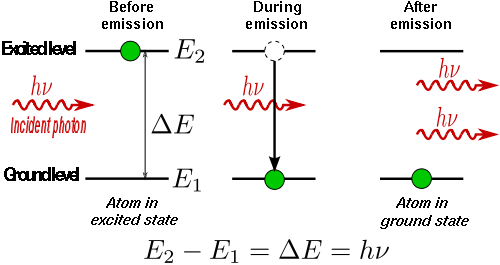The incident photon interacts with the atom and may cause the atom to come to lower state along with an emission of a photon. This process is called stimulated emission.
In contrast to this, there is energy states one lower (E1) and another higher (E2). If a photon of light having energy exactly equal to the difference of E1 and E2 is made to incident on the atom, the atom in the lower state E1 would absorb energy and reach the level E2. This process is called as stimulated absorption of light.

Since the atom is not in the ground state, but in the excited state, if left to itself the atom reaches the ground state by emitting a photon with energy = E2 – E1 spontaneously.
If the atom is in the higher (E2) energy and if the photon having an energy (E2 – E1) is incident on it, then something different happens. The incident photon interacts with the atom and may cause the atom to come to lower state along with an emission of a photon. This process is called stimulated emission. Here the emitted photon has the same energy phase and the direction of the incident photon.

Featured Image : Scientists have caught a laser beam in flight on video for the first time.
